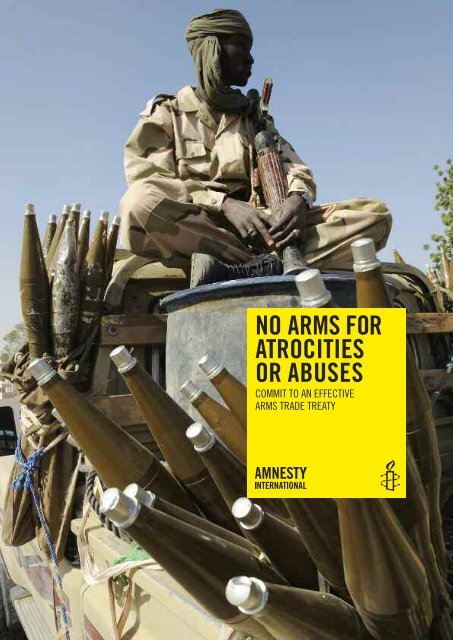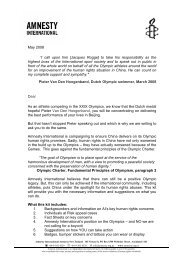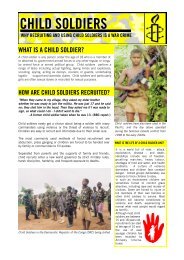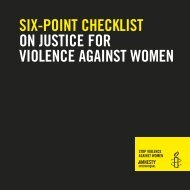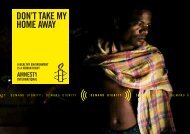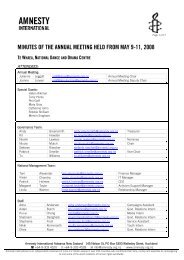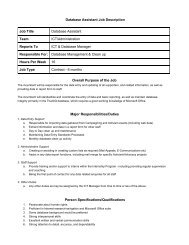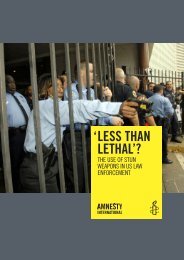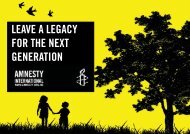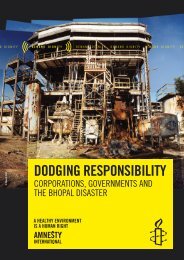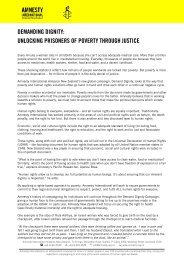Arms Trade Treaty Campaign Briefing - Amnesty International
Arms Trade Treaty Campaign Briefing - Amnesty International
Arms Trade Treaty Campaign Briefing - Amnesty International
- No tags were found...
You also want an ePaper? Increase the reach of your titles
YUMPU automatically turns print PDFs into web optimized ePapers that Google loves.
No arms foratrocitiesor abusesCommit to an effeCtivearms trade treaty
“He fell on the ground but nobody was able totake him away from the street as the tanks werenearby. That is when an army tank deliberatelycrushed his body repeatedly.”eyewitness account of the killing of Khaled al-hamedh in hama, syria© JOSEPH EID/AFP/Getty ImagesiNtroductioNEach year, the global trade in conventionalarms carries an enormous human cost.Serious human rights abuses have beencommitted around the world using a widerange of weaponry, armaments, munitionsand related material. Thousands of peoplehave been killed, injured, raped and forcedto flee from their homes as a result.Weaknesses and loopholes in existingnational, regional and multilateral armscontrol mechanisms have enabled statesand other parties to continue trading armsirresponsibly and with impunity. But nowthe absence of international standardsto adequately regulate conventional armstrading and transfers can finally beaddressed.In July 2012, UN member states will beinvited to the UN conference to negotiatean <strong>Arms</strong> <strong>Trade</strong> <strong>Treaty</strong>. Prior to this, stateswill be refining their positions on the<strong>Treaty</strong>’s content and participating in thefinal preparatory meeting in February 2012.Now is the time to ensure that the <strong>Treaty</strong>contains the highest possible commonstandards for the import, export andtransfer of conventional arms. This isessential to help prevent serious violationsof international human rights law andinternational humanitarian law.The likelihood of an international armstransfer being used to commit or facilitateserious violations of international law mustbe rigorously assessed and, where the riskis substantial, the transfer should not beauthorized. Risk analysis should alsoexamine the likelihood of any foreseeableevents to prevent such future violations.This briefing documents five personal storiesin the context of human rights violationscommitted or facilitated using conventionalarms in law enforcement or militaryoperations. The main suppliers of the types ofarms used by military, security or police forces,or armed groups are shown in each case.<strong>Amnesty</strong> <strong>International</strong> is calling on politicalleaders and state officials to take action forthe individuals in the following cases usingthe postcards provided and to lobby theirgovernments to commit to an effective <strong>Arms</strong><strong>Trade</strong> <strong>Treaty</strong> with respect for human rightsat its core.syriaLives Lost iN vioLeNtcrackdowNKhaled al-hamedhShortly after breakfast on 31 July 2011,21-year-old construction worker Khaledal-Hamedh left his home in the city ofHama to buy medicine for his four-year-oldbrother, who had a fever. He never camehome. Several hours later, family memberslaid him to rest in the garden of nearbyal-Serjawi mosque, his body crushed anda bullet wound in his back.When Khaled al-Hamedh walked out intoHama’s Bab Qebli neighbourhood thatmorning, Syrian security forces wereencroaching on the city with tanks andfiring into residential areas. Bystanders laterrecounted to his family that he had been“shot in the back while attempting to crossover to the hospital”. An army tank thendeliberately drove over him. Only when thetanks had pulled away could bystandersapproach and take Khaled al-Hamedh’sbody to the hospital.amnesty international January 2012 index: aCt 30/001/2012
Left: A Syrian military tank takes position ina residential street in the city of Homs, 160kmnortheast of Damascus, August 2011.Cover: A soldier of the Chadian national army(ANT) sits on a pick-up truck loaded withrocket propelled guns in front of thePresidential Palace in N’Djamena, Chad,February 2008.© PASCAL GUYOT/AFP/Getty Images3Un CustomsCategorymilitary weapons(89112)non-militaryfirearms (89131)munitions(89129)tanks and otherarmouredfighting vehicles(89111)suppliervalueUs$egypt 618,685egypt 296,785france 1,254,580india 1,132,320Total value of exports to Syria between 2005and 2009.Pro-reform demonstrations began in Syria inFebruary 2011 and became mass protestsby mid-March. The Syrian authorities haveresponded with extreme force in their effortsto suppress them. Tanks and otherarmoured vehicles have been used inmilitary operations and reportedly shelledcivilian residential areas in the towns andcities where protests have occurred.Security forces have shot people dead.Sniper rifles have also been used andsnipers have targeted people trying to helpthe wounded on the streets. The Syrian navyis alleged to have used gun boats to shellthe port city of Latakia.As of early January 2012, <strong>Amnesty</strong><strong>International</strong> has obtained the names of4,345 people who have been killed in thecrackdown. Many are believed to have beenshot by security forces using live ammunitionwhile participating in peaceful protests orattending funerals of people killed in earlierprotests. The Syrian authorities havearrested thousands of others, holding manyincommunicado at undisclosed locationswhere torture and other ill-treatment arereported to be widespread.main arms sUppliers to syriaThe Russian Federation is reportedly Syria’sbiggest arms supplier, with 10 per cent ofall its arms exports going there. These haveincluded missiles and missile launchers,and anti-tank missiles for the modernizedRussian-made T72 tank. Slovakia supplied139 T-72 tanks to Syria in the early 1990s.In 2008, Italy authorized approximatelyUS$3,680,150 under the licensing categoryfor fire control systems. This is possiblyrelated to an estimated US$200 millioncontract with Galileo Avionica of Italy, toupgrade 122 T-72 Main Battle Tanks withthe Tank Universal Reconfiguration ModularSystem T-series tank fire-control system.Few countries officially report on their armstrading with Syria. It is, therefore, difficultto identify which states have supplied thetypes of arms that have been used tosuppress protests.Egypt, France and India have also suppliedSyria with military weapons, non-militaryfirearms, munitions, and tanks and otherarmoured fighting vehicles over a five-yearperiod, according to UN trade data shownin the table above.Evidence of crimes against humanitycommitted by Syrian state forces continuesto grow. An effective <strong>Arms</strong> <strong>Trade</strong> <strong>Treaty</strong>could have helped to prevent such crimes.<strong>Amnesty</strong> <strong>International</strong> is now calling on theUN Security Council to impose an immediate,comprehensive arms embargo on Syria, andto refer the situation there to the Prosecutorof the <strong>International</strong> Criminal Court.recommeNdatioNsThe Syrian government should: Conduct a thorough, prompt, impartialand independent investigation into thekilling of Khaled al-Hamedh and into allreported deaths during or in connectionwith the protests since mid-March. Ensure that all those responsible arebrought to justice.index: aCt 30/001/2012 amnesty international January 2012
4© Private© <strong>Amnesty</strong> <strong>International</strong>chadeNforced disappearaNceof oppositioN Leaderibni oUmar mahamat salehIbni Oumar Mahamat Saleh (above), leaderof the Chadian opposition Party for Freedomand Development, was arrested on 3February 2008 at his home in N’Djamenaby the Chadian security forces. Aneyewitness said:“The soldiers kept us at bay with theirweapons and four of them went andknocked on the door of the house. A littlewhile later, Ibni Oumar came out with thesoldiers. One of them fired in the directionof one of the people standing at the door,accusing him of being a liar because hehad said that he did not know Ibni Oumar.”The arrest of Ibni Oumar and three othermen occurred during a two-day offensiveon the Chadian capital of N’Djamena byopposition armed groups in early February2008. The government stated that thosearrested were suspected of supportingarmed opposition groups.Intense fighting raged in various parts ofN’Djamena on 2 and 3 February beforegovernment forces regained control andthe armed opposition retreated across theborder into Sudan. Hundreds of civilianswere killed or injured and many people werearbitrarily detained, tortured and forciblydisappeared. These attacks occurredin the context of mounting tension withneighbouring Sudan. Both governmentsaccused the other of supporting andproviding bases to armed oppositiongroups.There were numerous aerial attacks in thecity using military helicopters. Fragmentsfrom the weapons used in the offensive,and obtained by <strong>Amnesty</strong> <strong>International</strong>,were found to be from an air-launchedS-5M 57mm HE fragmentation rocket.These rockets are typically fired from rocketlaunchers carrying between four and 32rockets, mounted on military aircraft orattack helicopters. They are unguided, highexplosive weapons and should not be usedfor attacks near civilian populationsbecause of their inability to distinguishbetween military and civilian targets.On 27 February 2008, the Chadiangovernment announced the establishmentof a Commission of Inquiry to examinehuman rights violations committed duringthe N’Djamena offensive, including thefate of Ibni Oumar Mahamat Saleh. Apresidential decree passed on 23 May 2011established a follow-up committee on therecommendations of the Commission.Despite investigations and numerousinterviews, the Commission was unable toascertain what happened to Ibni OumarMahamat Saleh. His fate and whereaboutsremained unknown at the end of 2011.<strong>Amnesty</strong> <strong>International</strong> considers Ibni OumarMahamat Saleh to be a victim of enforceddisappearance by the Chadian securityforces. During the last two decades, theorganization has documented numerousdisappearances of Chadian oppositionfigures and other individuals, particularlyin April 2006 in N’Djamena and November2007 in the Dar Tama region, easternChad. The ready availability of arms in Chadresulting from the absence of an effective<strong>Arms</strong> <strong>Trade</strong> <strong>Treaty</strong> has contributed toongoing violations of human rights there.amnesty international January 2012 index: aCt 30/001/2012
Part of an S-5M 57mm HE fragmentationrocket, recovered after an attack in February2008 involving armed opposition groups inN’Djamena, Chad. During two days of fighting,hundreds of civilians were killed or injured.5main arms sUppliers to Chad<strong>Amnesty</strong> <strong>International</strong> has documentedarms transfers to Chad involving a numberof countries including Belgium, France,Libya, Serbia, and South Africa. According to UN trade data, between2003 and 2010, France sold nearly US$4.7million worth of arms and ammunition toChad. However, in actual exports, the bulkof this figure relates to the delivery of nearlyUS$4.3 million worth of “munitions of war”in 2008 – the year in which the offensivetook place in N’Djamena. Annualgovernment reports on arms exports fromFrance to Chad between 2006 and 2010record approximately US$24.8 million,excluding military and civilian equipmentdonated by France to the Chadianauthorities. On 14 February 2008, theFrench Ministry of Defence acknowledgedthat the French army had assisted theChadian government in transportingammunition from Libya into Chad. In 2006, Serbia exported nearlyUS$900,000 worth of “other cartridges andparts thereof” to Chad, according to UNdata. A Chadian end-use certificate dated4 July 2006 and presented by an Israelibroker to the Serb authorities requestedthe sale of two million rounds of 5.56mmammunition for the “Forces Armées” andthe “Sécurité de la République du Tchad”. On 3 March 2007, there were reportsthat an order of 40 French-made AML 90armoured tanks, delivered to Belgium fromSouth Africa, had arrived in Chad. Theywere reportedly for use in the east of thecountry near the Sudanese border. ABelgian company known to supply suchvehicles declined <strong>Amnesty</strong> <strong>International</strong>’srequest to confirm or deny the delivery.However, the Belgian authorities statedthat no approval had been granted to shiparmoured vehicles to Chad. Instead,authorization was given to sell armouredvehicles to France, without any restrictionsas to further sales or transfers.Information on clandestine arms supplies toChadian armed opposition groups based inDarfur, Sudan, is more difficult to obtain.However, there is evidence that they havebeen using Chinese small arms and lightweapons. Examples include arms capturedfrom the Union of Forces of Democracyand Development and admissions byanother opposition group, the Rally ofForces for Change, both in 2007. In 2006,members of armed opposition group, theUnited Front for Democratic Change, werephotographed carrying Chinese-madeQLZ87 35mm automatic grenade launchersoutside the town of El Geneina in westernDarfur, near the Chadian border. Thegroup’s commander had just claimedto have visited China.recommeNdatioNsThe Chadian government should: Immediately disclose the fate andwhereabouts of Ibni Oumar Mahamat Salehand promptly inform his family and his legalrepresentative. Initiate an independent and impartialinvestigation into his enforceddisappearance and bring those responsibleto justice.index: aCt 30/001/2012 amnesty international January 2012
6© Private© REUTERS/Buddhika Weerasinghesri LaNkastudeNt shot deadragihar manoharanRagihar Manoharan (above) was one of fiveTamil students shot dead by Sri Lankansecurity forces in the north-eastern town ofTrincomalee on 2 January 2006. He was 20years old.Ragihar was with fellow students onTrincomalee’s seafront when someone ina passing auto-rickshaw threw a grenade,which injured several in the group. A shorttime later, 10 to 15 uniformed officersarrived, believed to be police from the eliteSpecial Task Force. They put the injuredstudents into their jeep and beat them withrifle butts before pushing them out ontothe road. Witnesses stated that the officersthen shot dead all five students, includingRagihar.A commission was established to investigatethe incident but its report has never beenpublished. No thorough investigation hasever been conducted and no one has beenbrought to justice for the murder of Ragiharand his companions.Sri Lanka emerged from a bitter andprotracted armed conflict in 2009. Theconflict between the government and thearmed separatist group, Liberation Tigersof Tamil Eelam (LTTE), lasted almost threedecades. Both parties committed serioushuman rights violations and tens ofthousands of civilians were killed; manymore were injured and abused.Despite these persistent serious humanrights violations committed by Sri Lankansecurity forces and the LTTE, and in theabsence of an effective <strong>Arms</strong> <strong>Trade</strong> <strong>Treaty</strong>,foreign governments continued to allow thesupply of a wide range of weaponry,munitions and other equipment to Sri Lanka.main arms sUppliers to sri lanKaA range of conventional arms have beensupplied to Sri Lanka between 2000 and2009 by several states including China,Czech Republic, Israel, Pakistan, RussianFederation, Ukraine and the USA. According to UN trade data, Pakistansupplied military weapons to Sri Lankaworth US$6 million in 2008 and 2009, andthe USA supplied US$6.4 million in 2007and 2008 respectively. Pakistan was alsoa major supplier of munitions. Between 2001 and 2009, major suppliersof munitions of war included Israel(US$2.88 million), Slovakia (US$4.3million) and the USA (US$3.95 million). China has supplied a wide range ofarms. For example, in May 2007, Jane’sDefence Weekly reported that, accordingto a cabinet memorandum, the Sri Lankangovernment agreed a US$37.6 milliondeal with Chinese company PolyTechnologies to supply munitions suchas cannon charge shells and mortars. Sriamnesty international January 2012 index: aCt 30/001/2012
Left: A Special Task Force motorcycle unitsoldier guards a roadside checkpoint inColombo, Sri Lanka, November 2008.Below: A funeral procession for five studentswho were killed by Sri Lankan security forcesin Trincomalee on 2 January 2006.7Lanka had a previous ammunitioncontract worth US$100 million withanother Chinese company, Norinco. Between 2000 and 2006, the mainsuppliers of heavy weaponry andarmaments, including battle tanks, armouredvehicles, rocket systems, combat aircraftand helicopters, were China, CzechRepublic, Israel, Pakistan, Russia andUkraine. European Union (EU) export data showsthat the UK, Czech Republic, Spain,Slovakia and Bulgaria were the largestsuppliers of arms to Sri Lanka between2001 and 2008. In February 2010, the RussianFederation and Sri Lanka signed a US$300million loan for the supply and repair of arange of arms, including military helicopters.The LTTE has continued to source armsthrough well-developed arms traffickingnetworks, and has captured much of itsartillery from the Sri Lanka Army.recommeNdatioNsThe UN Secretary General Ban Ki Moonshould: Establish an independent, internationalmechanism to investigate crimes underinternational law committed in Sri Lanka,including the killing of Ragihar Manoharanand his companions.© Private Make the results public and, where thereis sufficient evidence, prosecute thoseresponsible in proceedings that meetinternational fair standards.index: aCt 30/001/2012 amnesty international January 2012
8© Private© REUTERS/Albeiro LoperaLeft: Children of the San José de ApartadóPeace Community in Colombia.coLombiapersecutioN of a commuNityiN iNterNaL armed coNfLictthe peaCe CommUnity of san José deapartadóColombia’s internal armed conflict haspitted security forces and paramilitariesagainst guerrilla groups for more than 45years. The Peace Community of San Joséde Apartadó was created in March 1997,when people living in villages of the Apartadómunicipality, north-western Colombia,pledged not to be drawn into the violence.Their decision has been met with suspicionand hostility from all sides.Since then, more than 170 members of thePeace Community and other civilians livingin the area have been killed or forciblydisappeared, while others have beenthreatened or sexually assaulted, the vastmajority by army-backed paramilitaries andthe security forces. Guerrilla forces havealso been responsible for numerous threatsand killings.Heavily armed paramilitaries are still presentin the area, despite the deployment ofsoldiers and police there, and governmentclaims that all paramilitaries havedemobilized.Paramilitaries have repeatedly threatenedto kill members of the Peace Community.On 23 March 2011, the 14th anniversaryof the Community’s creation, paramilitariestold a Community member that they had toleave or the killings would continue. Theparamilitaries also warned that they hadplanned with the security forces to“exterminate” the Community. On 19 and20 November 2011, paramilitaries set uproad checkpoints around hamlets nearby.They told people from the Community thatthey were forbidden from taking food backto their houses. These threats came at atime when there were reports thatparamilitaries had consolidated theirpresence in the areas around the PeaceCommunity.Killings, threats and enforced disappearanceshave become commonplace in theCommunity and to date, the governmenthas not put in place and implementedadequate protection measures to ensurethe safety of those living there.Members of the security forces havealso regularly threatened members ofthe Community. Guerrilla forces of theRevolutionary Armed Forces of Colombia(Fuerzas Armadas Revolucionarias deColombia, FARC) continue to threatenand kill civilians they consider to becollaborating with their enemies. InFebruary 2011, FARC guerrillas werereported to have killed two people livingin the area of San José de Apartadó; onewas known to have close links to theCommunity.Despite repeated orders from the Inter-American Court of Human rights, theauthorities have failed to take effectiveaction to protect them, falling short of theirobligations under international law.<strong>Amnesty</strong> <strong>International</strong> is concerned that,in the absence of an effective <strong>Arms</strong> <strong>Trade</strong><strong>Treaty</strong>, Colombia has been inundated foryears with military weapons – especiallysmall arms and light weapons (SALW) –which are often used to commit or facilitateamnesty international January 2012 index: aCt 30/001/2012
A policeman guards weapons confiscated froma paramilitary group during a raid in Medellín,Colombia, September 2008.9recommeNdatioNsThe President of Colombia should: Ensure that protection measures are putin place and implemented in agreementwith the Peace Community of San José deApartadó to ensure the safety of itsmembers. Investigate the killings, sexual abuses,threats and enforced disappearances ofPeace Community members, publish theresults and bring those responsible tojustice. Take action to dismantle paramilitarygroups that continue to operate in the areaof San José de Apartadó and break theirlinks with the security forces.serious violations of human rights and warcrimes.<strong>Amnesty</strong> <strong>International</strong> is also concernedthat, until the Colombian authorities fullyimplement UN human rightsrecommendations, there can be noguarantee that arms transfers to Colombiawill not exacerbate its human rights crisis.The absence of such a guarantee will deterthe authorities from acting decisively todismantle paramilitary groups and breaktheir links with the security forces.main arms sUppliers to ColombiaColombia has a profitable, self-sufficientmilitary industry organized under theIndustria Militar (INDUMIL). However, ithas imported large quantities of militaryweapons, revolvers and pistols, andmunitions from several countries.According to UN trade data, between 2007and 2010 Colombia imported nearlyUS$300 million worth of military weaponsfrom countries including the USA, Israel,Italy, France, Turkey, Spain and the UK.Nearly US$17 million worth of pistolsand revolvers have come from countriesincluding USA, Israel, Turkey, CzechRepublic and Germany. Almost US$260million worth of munitions have come fromcountries including Israel, South Africa,USA, Brazil, Republic of Korea, Turkeyand Italy.According to the Colombian authorities,between 2007 and 2010, only US$1 millionworth of civilian firearms were imported.However, export data from suppliercountries indicates that US$20 millionworth of civilian firearms were exportedto Colombia in the same period, of whichUS$11 million worth were imported fromthe USA and US$8 million from Israel.The U.S. Department of State continues toprovide the Colombian security forces withmilitary aid and training. By the end of2011, the USA had allocated US$345million for the Colombian security forces, ofwhich US$50 million were designated for thearmed forces, 30 per cent of which wasconditional on the Colombian authoritiesmeeting certain human rights requirements.In September 2011, about US$20 million insecurity assistance funds from 2010 werereleased after the US authorities decidedthat the Colombian government had madesignificant progress in improving Colombia’shuman rights situation.On 1 September 2009, the U.S.Department of Defense awarded a threeyearUS$353 million contract for 9mm SigSauer pistols and spare parts, of whichUS$46 million (or 99,261 9mm pistolsand spare parts) are destined for Colombiathrough a Foreign Military Sales agreement.The pistols were due to be deliveredbetween July 2009 and May 2012.In general, illicit market shipments of smallarms and light weapons to Colombia aresmall, but they happen frequently. Illicitsupplies of such arms to the paramilitariesand guerrilla groups in Colombia enter thecountry through neighbouring states. Bothparamilitary and guerrilla groups have alsotried clandestinely to procure small armsand light weapons directly on theinternational market through arms brokeringand trafficking networks.index: aCt 30/001/2012 amnesty international January 2012
10© Orestis Panagiotou-Athens press agencyLeft: Injured journalist Manolis Kypreosdescribes to members of the press the momentwhen a police officer allegedly threw a stungrenade in front of him. Athens, Greece,June 2011.© AP Photo/ Petros GiannakourisGreeceJourNaList iNJured by poLicestuN GreNademanolis KypreosOn 15 June 2011, journalist ManolisKypreos’ hearing was permanently damagedwhen a police officer threw a stun grenadein front of him.Numerous protests have taken place inAthens and other major Greek cities during2011 against austerity measures beingintroduced by the government. Manolis wasdoing his job reporting on the protests inAthens when he witnessed police sprayingchemicals at peaceful protesters, throwingstun grenades at them and beating themwith police batons near Syntagma Square.The police told him to stop taking photos.Manolis produced his journalist accreditationbut the head of the riot police unit swore athim and pointed him out to another officerwho then threw a stun grenade. Theexplosion, approximately 50cm fromManolis, knocked him to the ground. Afterdemonstrators helped him to his feet again,he realized that he could not hear.Surgery may help Manolis regain somehearing in one ear but his second ear ispermanently damaged. A criminal and adisciplinary investigation have been openedby the Greek authorities regarding his case.He has also filed a lawsuit asking forcompensation and reparations from theGreek state.<strong>Amnesty</strong> <strong>International</strong> has documentedseveral cases of excessive use of forceby the police and excessive use ofchemicals and tear gas during the recentdemonstrations in Greece. The PublicProsecutor of the Athens First InstanceCourts is currently undertaking criminalinvestigations into the allegations ofexcessive use of force, including with teargas, by the police during the 15, 28 and29 June demonstrations. A Greek memberof parliament has asked the government toclarify the health impacts of the use of teargas by the police.<strong>Amnesty</strong> <strong>International</strong> has long-standingconcerns about policing in Greece,including a culture of impunity thatprevails among law enforcement officials,excessive use of force against protestersand ill-treatment of individuals in custody.Yet, without legally binding human rightscriteria under an <strong>Arms</strong> <strong>Trade</strong> <strong>Treaty</strong>, policeweapons and munitions have beencontinually supplied to Greece by foreigncompanies.“I truly hope I am the lastvictim of police violence. Indemocratic societies, problemscan’t be solved with violencebut through dialogue.’’manolis Kypreos at a press conference, 12 July 2011amnesty international January 2012 index: aCt 30/001/2012
Protesters clash with riot police outside theGreek Parliament during a demonstration bythe Panhellenic Federation of WorkersAssociation (POE-OTA) in May 2011. Theunion was protesting against an increase inworking hours for civil servants.11financialyearamountUs$2000 18,5962002 5,0252004 4,1252007 27,0702008 55,2502009 55,5612010 103,137The export of riot control agents (including teargas) from the USA to Greece increasedsignificantly between 2000 and 2010.main poliCe arms sUppliers togreeCeAccording to evidence gathered by <strong>Amnesty</strong><strong>International</strong> during the June 2011 protests,the stun grenades and tear gas canistersrecovered in Syntagma square a day afterthe 29 June demonstration were made inBrazil, Germany, UK and USA. Theseincluded: GL-311 tear gas grenade, made byCondor Tecnologias Não Letais in Brazil. 2-bang “sound and flash” device byGerman company Nico Pyrotechnik inOctober 2001. N591 Stun Grenade, made by the UKbasedcompany Chemring; Tear Ball Multi Effect Grenade and the8230 Tactical Grenade – both made by USmanufacturer Combined Tactical Systems;and the 555 CS grenade made by UScompany Federal Laboratories.It is not known when the grenades used bypolice in June were transferred to Greece.The Brazilian GL-311 tear gas grenade hada manufacturing date of September 2010but Brazil does not publish an annual reporton its arms exports.According to EU annual reports on armsexports, Germany has licensed ammunitionexports to Greece annually since 2003 andUS$1,121,330 worth of toxic agentsbetween 2003 and 2005, including riotcontrol agents such as tear gas.In 2010, according to government data, theUK authorized an open export licence,which can last between two and five years,allowing multiple shipments for a range ofpolicing equipment to Greece. Thisincluded CS hand grenades, stun grenades,tear gas and other riot control agents. TheUK also licensed stun grenades to Greecein 2003, 2005, 2007 and 2008. Since2000, the UK authorities periodicallyauthorized open licences for a companyselling a variety of stun, smoke and tear gasammunition.recommeNdatioNsThe Greek Minister of Justice and GreekMinister of Citizens’ Protection shouldensure that: The criminal and disciplinaryinvestigations into the injury and illtreatmentof Manolis Kypreos are prompt,independent, thorough and effective. The police officers responsible for hisinjury and ill-treatment are brought tojustice, and disciplinary measures arebrought against them. Manolis Kypreos is provided withcompensation which takes full account ofthe consequences of his loss of hearing.index: aCt 30/001/2012 amnesty international January 2012
© Aris Chatzistefanou/DemotixRiot police use tear gas to break up protestsin Syntagma square in Athens, Greece,June 2011.arms trade treatyrecommeNdatioNsEach of the examples described abovedemonstrate how a wide range of weaponry,munitions and related equipment have beenused by police, security and military forcesand armed groups to facilitate or commitserious violations of human rights and warcrimes. They underscore the urgent needfor rigorous risk assessments of all proposedarms exports under an <strong>Arms</strong> <strong>Trade</strong> <strong>Treaty</strong> tocombat the poorly regulated internationaltransfer of conventional arms and help endthe devastation that the misuse of suchweapons inflicts on civilian lives.The <strong>Treaty</strong> must include strong human rightsparametersStates must ensure that an internationaltransfer of conventional arms will not bepermitted where there is substantial risk thatthose arms are likely to be used to commitor facilitate serious violations of internationalhuman rights law or international humanitarianlaw. An effective rigorous assessment of eacharms transfer licence application must firstbe undertaken to determine the risk.The <strong>Treaty</strong> must apply to all types andcomponents of conventional armsStates must define the scope of conventionalarms to include all weaponry, munitions,armaments and related articles used forpotentially lethal force in military and lawenforcement operations, as well as any parts,components, accessories, machines,technologies and technical expertise formaking, developing and maintaining thosearticles.Implementation of the <strong>Treaty</strong> must be robustand enforceableStates should agree standards for full, clearimplementation of the <strong>Treaty</strong>, includingnational authorization and licensing systems,and criminal and administrative sanctionssupported by public reporting andtransparency, as well as an effectivemechanism to monitor compliance.amnesty international is a global movement of more than 3 millionsupporters, members and activists in more than 150 countries andterritories who campaign to end grave abuses of human rights.our vision is for every person to enjoy all the rights enshrined in theUniversal declaration of human rights and other international humanrights standards.We are independent of any government, political ideology, economic interestor religion and are funded mainly by our membership and public donations.index: aCt 30/001/2012englishJanuary 2012amnesty internationalinternational secretariatpeter benenson house1 easton streetlondon WC1X 0dWUnited Kingdomamnesty.org


